The weekend of June 10, 11 and 12 will occur in Genzano di Roma, in the heart of the Castelli Romani, the 245th edition of the Infiorata. This traditional celebration fills entire streets of cities throughout Italy with artistic and cultural spectacles that leave amazed. Following traditions and procedures settled over the centuries, artists from all over the world try their hand at colourful paintings made of flower petals. Indeed, the very name “Infiorata” contains the word”flower”, the Italian “fiore”, in it and it is part of a worldwide tradition of Flower Carpets.

A tour to discover the Castelli Romani on the occasion of the Infiorata di Genzano
An unmissable opportunity for those in Rome and its surroundings in the period of the Infiorata to discover the Castelli Romani. The name refers to a group of small cities, whose origins date back to Roman times, in the hills surrounding Rome. The cities that belong to the area of Castelli Romani are Frascati, Nemi, Genzano, Ariccia, Albano, Monte Porzio Catone, Rocca di Papa and Marino. This tour travels between five of these beautiful little villages, exploring picturesque glimpses of a history that intertwines with ancient Rome’s most influential names and events.
5. Nemi city of strawberries
Part of the beauty of the territory of the Castelli Romani is found in the strong identity imprint that distinguishes each of these small but vibrant realities. Although so close to each other, these villages exude a marked and characterizing personality. So, if Genzano is artistic, Albano historical, and Ariccia cheerful, Nemi is undoubtedly delicate and picturesque.
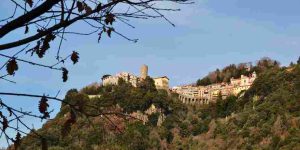
This is because of the tower of Palazzo Ruspoli overlooking the lake, the balconies of the houses overlooking the green of the banks and the blue of the waters, the walls decorated with strawberries and the viewpoint hidden between pergolas and ancient fountains. In other words, Nemi is a delight for the eyes and the spirit.
Famous for its strawberries, with which the Nemorians indulge in producing delicious sweets, jams, liqueurs and aperitifs, Nemi hides pieces of history of singular importance. Along the shores of the lake, noteworthy is the Museum of Roman Ships. Here are stored two colossal ships, found on the bottom between 1929 and 1931, belonging to the emperor Caligula. This magical place is the ideal destination for lovers of history and events in which these territories have lived as protagonists for many centuries.
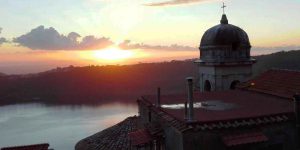
4. Ariccia: land of Bernini and a rich food and wine tradition
Ariccia is the watershed between the two lakes: halfway between Albano and Genzano, it bridges the slopes of the two volcanoes of the Colli Albani. And in fact, a panoramic bridge marks the entrance to the city, letting the eye wander over the entire plain below to the sea.
To welcome you is the Collegiate Church of Santa Maria Assunta, designed by Gian Lorenzo Bernini, as evidenced by the unmistakable blue dome, further proof of this great Baroque artist in the territory of the Castelli Romani.
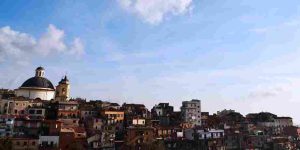
However, as well as from a historical-cultural point of view, Ariccia also has a lot to say on the side of typical specialities. First of all, the PGI porchetta is a famous product worldwide, made of spiced boneless pork, born in the Latium territory. And the best place to taste it is undoubtedly the bruschetta, the typical Roman tavern with abundant dishes made strictly with products of the Lazio hinterland: tripe, beans with kale, carbonara pasta, amatriciana and cacio and pepper, grilled vegetables and cheeses, all accompanied by excellent wine in a cheerful and convivial atmosphere.
6 Aprile: Carbonara Day, storia e ricetta di una pasta unica al mondo
3. Albano: on the traces of the past of ancient Rome
These territories bear the marks of the strong imprint that Rome has left in their architecture and in their present. As soon as you arrive in Albano, you will be captured by the green of the gardens of Villa Doria-Pamphili, initially owned by the very powerful Roman family.
And again, the ancient parish church of San Pietro Apostolo, dating back to the sixth century, whose bell tower in Romanesque style testifies to its antiquity.And then, the catacombs of San Senatore, a refuge in which Christians secretly practised their worship, which seem to date back to the third century.

But it is possible to go even further back in time and arrive at a historical era of which the very name of Albano is a witness: it is, in fact, in these territories that stood Alba Longa, the city founded, according to Virgil, by Ascanius – otherwise known as Iulus, son of the Trojan hero Aeneas who would have landed on the Lazio coast. According to legend, so began the Gens Iulia, to which belonged Julius Caesar, Augustus and several emperors up to Nerone.
Today Albano is a cosy town where you can take refuge in the cool shade of the high pines of Villa Doria or take a long walk that connects Albano and Ariccia.

2. Castel Gandolfo and the lakes of Castelli Romani
Lake of Nemi and Lake of Albano are the two lakes of volcanic origin around which are perched some of the towns that form the so-called Castelli Romani: Genzano and Nemi on Lake of Nemi, Albano and Castel Gandolfo overlooking Lake of Albano.
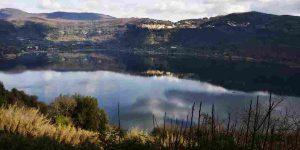
Lake of Albano
Lake of Albano is the only one of the two lakes where you can take a swim: the black sand beaches surrounded by trees are easily accessible and ideal for relaxing and refreshing in the clear waters.
From the lake, it is also possible to admire Castel Gandolfo as if from a postcard: among the low and colourful houses stands the Pontifical Palace, the Pope’s summer residence since the seventeenth century, from which every year in mid-August, the Pope looks out to greet the faithful.

The Pontifical Palace
The Palace is also a museum open to the public where you can visit some of the rooms that, over the centuries, have witnessed the lives of the popes. You will have the opportunity to observe the relics and artefacts preserved here and to walk in the labyrinthine paths of the gardens of Villa Barberini, the private gardens of the Pope. Finally, the site evokes and reaffirms the link between the Castelli Romaniand ancient Rome: the Palace was built on the remains of the ancient imperial villa of Domitian, whose remains are still visible today while touring the wonderful park.
1. The Infiorata of Genzano di Roma
The tradition of the Infiorata dates back to the Baroque era and finds its origins in Genzano, among the streets of the ancient peasant village. It would seem that it was Gian Lorenzo Bernini, a famous Roman artist, who advanced the idea of creating floral paintings for the liturgy of the Corpus Domini in the area of the Colli Albani.
The event, which saw the light for the first time in 1778, since 2011 is counted as the “Heritage of Italy for Tradition“, with special mention of the Ministry of Tourism, who recognized it as an “expression of the ability to promote tourism and the national image and to enhance the history and culture of the territory with an interpretation appropriate to today’s times“.
The 2023 edition, in parallel with this celebration, takes place from 10th to the 12th June. For the occasion, the entire town of Genzano di Roma mobilizes to welcome the many visitors eager to admire the works of the Maestri Infioratori.
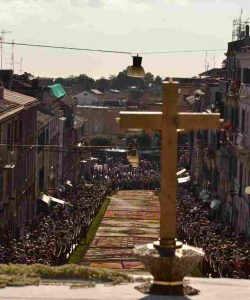
The theme of the 245th edition of the Infiorata of Genzano
The Maestri Infioratori will create original works of art that, for the 245th edition, will have the theme “I am the other”. A hymn to peace, an invitation to brotherhood and harmony among peoples. The sketches of the paintings will be presented on June 9 and, from that moment, in the municipal courtyard, will begin the phase of “spelluccamento”, the slow process of collecting petals.
The days of the Infiorata: the laying of the petals and the “spallamento”
During the three days of the event, the sketches of the paintings will be exhibited in the Sala del Belvedere of the Municipal House, while for the artists, the next step is the drawing on the pavement that will be the basis for the laying of the petals. The latter is undoubtedly the most exciting and intense moment of the event, and part of its charm is in the possibility of admiring a work in progress.
From simple plaster lines just mentioned on the pavement, witnessing the evolution into magnificent explosions of colours and shapes will be a spectacle, to say the least, unique and unparalleled.
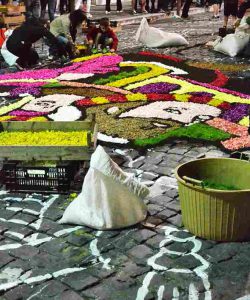
Curiosities about infiorata
A question, without any doubt, blossoms in the mind of those who admire the artistic and meticulous laying of petals: how do they not fly away during the days? The secret is to wet the petals in order to make them heavier, preventing them from moving and vanishing hours of collective work.
Meanwhile, the city comes to life with shows, live music and guided tours. The program will end with the pyrotechnic show on the evening of Sunday, June 11. The next day is dedicated to the “spallamento of the Infiorata“, a moment left to the children who can thus have fun destroying the floral compositions without hesitation.
The places of the Infiorata: the Church of Santa Maria della Cima and Lake of Nemi
The Infiorata takes place along Via Italo Belardi, the suggestive road uphill that connects the Church of Santa Maria della Cima and Piazza IV Novembre. Symbol of the city, the square also houses the Fountain of San Sebastiano, dating back to the eighteenth century and witnessed all the editions of the Infiorata di Genzano.
The column of the fountain, the emblem of the family Colonna, Lords of Genzano, is decorated with vine leaves, a typical crop of the Castelli Romani area.
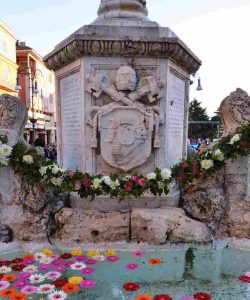
Going up the road, you reach the fourteenth-century Church of Santa Maria della Cima, built by the Cistercian monks. We are in the oldest part of the town and, continuing between the houses of the historic centre; you can reach the slope overlooking Lake of Nemi.
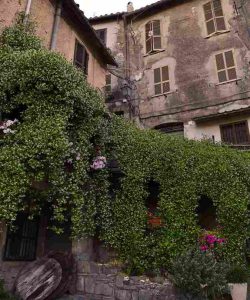
The territory of the Castelli Romani is a pearl a few kilometres from Rome. It is undoubtedly a destination to add to your itinerary if you can stop for a few more days in the Capital. If, instead, you have the most limited time to visit the Eternal City, it is good to have a well-marked itinerary so as not to miss any of its wonders.

